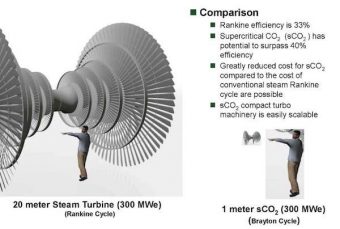
Concentrating solar power may have finally found its one true love: supercritical carbon dioxide, aka sCO2, which is something that happens when carbon dioxide gas behaves like a liquid. The electricity generation field is all aflutter with the idea that sCO2 can ramp up power plant efficiency while cutting costs, and concentrating solar power could be just the ticket. Wait, how does that even make sense?
Why Concentrating Solar Power Even Makes Sense
Fuel efficiency is just one part of the sCO2 allure. The US Department of Energy also totes up reduced water use and a much smaller footprint (see illustration) among the bennies.
In the olden days, fossil fuels and nuclear energy would have been the go-to energy applications for sCO2, but nowadays the Energy Department’s Supercritical CO2 Tech Team is also exploring other options, including shipboard power, waste heat recovery, and geothermal energy as well as concentrating solar power.
The concentrating solar power angle is an interesting twist. The technology was championed by the Energy Department during the Obama administration. For those of you new to the topic, it involves collecting solar energy from fields of mirrors called heliostats, or from long troughs, and using it to heat a specialized oil or molten salt, which can then be used to generate electricity in a power station.
If that sounds both simple and complicated at the same time, it is. Concentrating solar power initially got a bad rap due to its relatively high cost, but the tradeoff is something that renewable energy fans dream about: the ability to replace conventional power plants with 24/7 clean electricity. The heated oil, salt, or whatever acts as built-in energy storage, enabling the plant to continue generating electricity at night.
Somewhat weirdly, the Trump* administration has also been pursuing concentrating solar power hand over fist and soup to nuts. That’s weird because if all goes according to plan, the technology will close down more coal power plants, and didn’t the soon-to-be former president promise to save coal jobs?
Bringing Down The Cost Of Concentrating Solar Power
“Ensuring low-cost, reliable electricity for all Americans while minimizing risk is a top priority for this department,” US Energy Secretary Dan Brouillette said when he introduced the new USD 130 million round of solar funding.
No kidding! With that send-off, Heliogen is tasked with overseeing a SETO initiative called “Integrated Thermal Energy STorage and Brayton Cycle Equipment Demonstration,” or Integrated TESTBED for short.
“The supercritical carbon dioxide (sCO2) Brayton cycle carries great potential for a high‐efficiency, low‐capital-cost option,” SETO explains. “This project team will develop, build, and operate an sCO2 power cycle integrated with thermal energy storage at temperatures in the range of 550°C to 630°C at a new or existing facility.”
“The goal of this topic is to accelerate the commercialization of the sCO2 Brayton cycle and provide operational experience for utilities, operators, and CSP developers,” SETO adds.
More:
As the awardee, Heliogen will put up USD 31 million in cost sharing for the new system, which is expected to deploy readily available stainless steel alloys. That’s an important point because one of the challenges of sCO2 involves stress on system materials.
How Trump Could Help Kill The Global Fossil Fuel Industry
If all goes according to plan, concentrating solar could become another technology export industry for the US economy. The technology may be languishing in the United States, but it has taken hold in other parts of the world. In that case, the Heliogen project could end up making a significant impact on global decarbonization.
That’s bad news for US fossil fuel workers, whose jobs the Commander-in-Chief promised to save, and it’s not the only R&D area in which the Trump administration has fallen asleep at the fossil fuel wheel.
Not that we’re complaining or anything, but low-cost perovskite solar cell technology is another tech on which the Energy Department is eager to slap a Made in the USA stamp.

The Energy Department can also take credit for kickstarting a firm called Principle Power, which is emerging as a global leader in floating offshore wind technology, and now the agency is keen on promoting new floating solar panels as well.
Then there’s this new international pumped storage hydropower initiative and a new collaboration with the Netherlands that looks an awful lot like green hydrogen.
If President-Elect Joe Biden is serious about tackling climate change (spoiler alert: he is), it sure looks like he has a running start.
As for Heliogen, for those of you keeping score at home, that is yet another Bill Gates venture. That’s an interesting twist because Gates also has a nuclear energy firm called TerraPower in his fold. TerraPower launched with an apparent focus on the Chinese market, but it seems that the firm is shifting gears and taking a look at the potential for seagoing nuclear energy to power ships.
Interesting! Land-based opportunities for nuclear energy in the US are withering on the vine as renewable energy costs drop, and Gates’s own sCO2 venture through Heliogen could have a hand in that trend by pushing down the cost of concentrating solar power.
Oh well, water under the bridge. This is where the pieces fall into place. With its superior efficiency and the potential for lower costs, sCO2 could help make concentrating solar power more competitive in the sparkling green economy of the future.
Where The sCO2 Rubber Hits The Solar Power Road
The US Department of Energy has indeed been eyeballing the high efficiency of sCO2 to help reduce the cost of concentrating solar power, and that brings us to the latest coal-killing news. President Trump* has just a few weeks left in office, but it appears that he has left US coal workers a love letter (the bad kind, not the good kind) in the form of a USD 39 million Energy Department grant to a concentrating solar power firm called Heliogen.
The USD 39 million grant is a decent slice out of the Energy Department’s newly announced USD 130 million round of funding through its Solar Energy Technologies Office. That’s interesting because some energy industry observers are feeling like concentrating solar doesn’t make sense unless you apply it to oil and gas extraction, which kind of defeats the whole purpose of renewable energy.
Nevertheless, what’s sauce for the goose is sauce for the gander, as they say. Demand for oil and gas is set for a long, hard fall, meaning that the extraction market for CSP is going to dry up, eventually.
If and when it does, the Energy Department is already eyeballing the industrial market, as concentrating solar can produce the high heat needed in many processes that currently rely on fossil fuels.
Source: CleanTechnica



